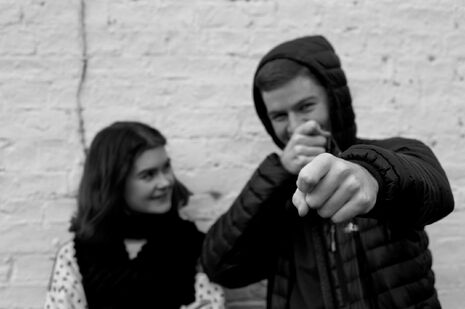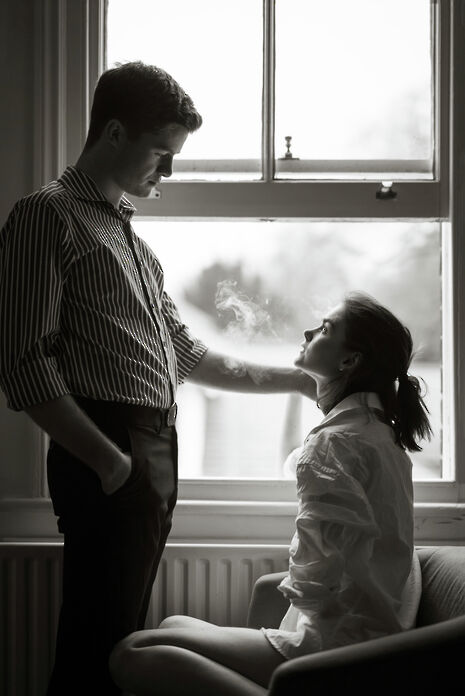On student writing: “I think it’s really important to take risks”
Student playwright Isla Cowan discusses her upcoming production, Come Back to Bed: could it really be influenced by the English Tripos’ Tragedy paper?

Working on Come Back to Bed has been an intense and rewarding process. I began writing the script last summer and finished it over Michaelmas, in between other rehearsals and writers groups – and my degree, of course. In that respect, I think, perhaps, the Tragedy Paper has influenced it quite considerably (it’s not a very cheery thing!), as well as everything I was learning while working on other plays.
The play is an exploration of a destructive relationship. Clara (Jessica Murdoch) and Ben (Christian Hines) have been casually ‘sleeping together’ for about three weeks, and the play dramatises one afternoon where Clara has actually stuck around long enough for them to talk. Ben really tries to engage in this. He wants to get to know her; he wants their relationship to develop. Meanwhile, Clara pushes him away and keeps her distance. She always seems distracted. It’s clear that they both need each other in a way, but that this ‘need’ in itself is violent and damaging.
“The play is an exercise in ‘intense realism’”
I’ve often said that the play is an exercise in ‘intense realism’, in order to describe the fact that it’s raw and gritty and non-romantic. However, I think this forgets the abstract quality to it all. There is something un-real about the characters, their behaviour is strange and unpredictable. They’re not quite ‘normal’. At the same time, the movement sequences offer an abstract or alternate ‘dream’ world: each sequence is a release from the binds of naturalistic dialogue and a moment where the characters’ suppressed emotions can be brought to the surface.

Similarly, alternate worlds or ‘layers’ appear in the multiple time frames of the play: it is set on one rainy afternoon, which plays out continuously, but there’s also the idea that, underneath this, both characters are actually stuck in a constant, never-ending past; and then there’s a cyclical element to it all, as well, where their phrases echo each other and anticipate future actions. On top of this, Clara has a unique ‘literary’ temporality or tradition, in which allusions shape what she says and does, though it’s not quite clear how conscious she is of this process – whether she actively indulges in the fantasy of the suffering tragic heroine or whether that’s a restriction the play puts on her, a poetry she’s forced to perform.

Even in the early stages of writing, I always intended for there to be physical theatre laced throughout the dialogue of the play. Jonathan Ben-Shaul (Movement Director) has been such a joy to work with and his choreography for the play is incredible. Each movement sequence began with a rough idea or feeling – usually some vague rambling thing I had in mind and didn't express very well – and Jonathan was able to take that and develop it, making it into something amazing. It’s been great having him in the rehearsal room too, as we sort of act like ADs for each other — I pitch in with movement suggestions and he comments on blocking.
Come Back to Bed does take some risks in its content and style – but I think that it’s really important to take risks, especially in student theatre, where you have the opportunity to experiment and push limits. This play puts a complex, difficult relationship on stage and creatively explores characters being pushed to their limits, in love, loneliness and destruction.
Come Back to Bed runs Thurs 2nd - Sat 4th March, from 8pm at Fitzpatrick Hall, Queens' College
 News / Uni members slam ‘totalitarian’ recommendation to stop vet course 15 January 2026
News / Uni members slam ‘totalitarian’ recommendation to stop vet course 15 January 2026 News / Cambridge bus strikes continue into new year16 January 2026
News / Cambridge bus strikes continue into new year16 January 2026 Science / Why smart students keep failing to quit smoking15 January 2026
Science / Why smart students keep failing to quit smoking15 January 2026 Interviews / The Cambridge Cupid: what’s the secret to a great date?14 January 2026
Interviews / The Cambridge Cupid: what’s the secret to a great date?14 January 2026 Comment / Will the town and gown divide ever truly be resolved?12 January 2026
Comment / Will the town and gown divide ever truly be resolved?12 January 2026








